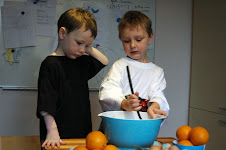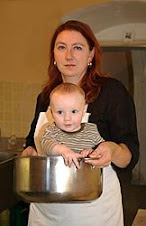
This is my home made cheese. Looks a lot like those made in abruzzo by handy housewives with a farming background, but it is absolutely different. It is no ricotta, as it may seem, but labna. Tastes lots like a stracchino made from yogurth.
The following recipies are as strange to Abruzzo as you can imagine, but it is my village youth in Ofena and Tortoreto, I believe, to get me the feeling for self production. It all started with the discovery that at a 10 minutes drive from my hous in Amsterdam (the Netherlands) there was an organic farm. For all romantic fall pictures please see here.
Had I known of this when my mom found out in Ofena that the lady keeping sheep and goats (and winning every year the contest of most beautyful ram of the region) could provide us with raw, fresh milk. We used to bring her a 1,5 liter recycled ice-tea bottle, as it had a larger opening that regular bottles, and she had a goat who made daily just about that quantity. Back then I was giving my baby goat milk from the supermarket, because I suspected him of being sensitive to cow-milk.
Raw milk is now becoming a trend, and what I love about Italy is that more and more farmers do get a milk-tap machine, and install it in different crowded paces, so you can go day and night to pick up you own milk in your own bottle. They recommend you boil it to about 72 Celsius before drinking, but we don't, and so it tastes so much better.
Yogurth
To make yogurth you need any amount you like of milk (supermarked milk is OK too), a starting colture of yogurth (can be bought the first time, or you can save everytime a cup for the next batch), a pan with a good fitting cover (I use the pressure-pan as the cover can be closed perfectly) and an old blanket, sleeping bag, sweaters, whatever you want to keep the pan warm.
You start by boiling the milk and then let it cool down until you can keep your kand in it and count to 10 without burning yourself (about 45 degrees Celsius).
Than you add the yogurth (about 3-4 cups per gallon), mix, cover the pan, wrap it in the blankets and put it to rest in a quiet place. Usually I put it under my bed so that nobody will be bothered by it. You let it stay for about 12 hours, so I usually start warming up the milk while cooking dinner, and have my yogurth ready for the next breakfast. you might want to mix it when ready.
I know of people making yougurth in a thermos, and thus saving themselves all the trouble with blankets etc. but I use it to make chesse as well, so I need lots.
Labna-cheese
Take any quantity if yogurth you want to use, considering that the volume of the cheese will be at least 4-5 times less than the volume in yogurth. Add salt to taste (if you use little salt, and Americans usually do that, compared with South-Europeans, add more than you would consider OK). Mix well.
Prepare a strainer, rinse with lots of water a clean white cloth (otherwise your cheese will taste of softener, which you don't want. Ideally you wash your cheese cloth only with hot water), put the cloth inside the colander and pour your salted yogurth in it. Hang the strainer on top of your sink or put it inside a bowl deep enough to collect all the water leaking from the cheese, without having it hanging in it. Consider that lots of water will come out.
My kitchen used to be unheated during the day, so I did it just on a table. you might want to hang the hole thin in th fridge. In this case, don't use the colander, but tie well the cloth and hang it above the bowl. I know someone who bought especially for the cheese a clean white cotton sock (if you can find unbleached cotton, than you deserve the organic-housewife of the year award), as it avoided mess and it hung so much more easily.
After a few hours all the excess water left. ;eaving behing a creamy cheese. I scoop it away from the fabric with a spoon, press it in a small bowl, and keep it in the fridge. Before serving I turn it on a small plate or saucer and serve it. The one in the picture was made with 3 lt. milk and had a diameter of 15 cm at the base.
I eat it spread on bread or crckers, and as a lean alternative to sour cream in soups or other dishes. Keep in mind that it is salty, so the dish should not have much salt on its own. I love it with pumpkin soup, but should try it with corn soup or any other sweet vegetables (how's about sweet potatoes, or carrots?).































